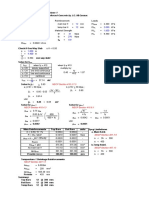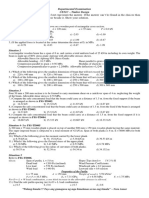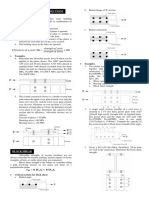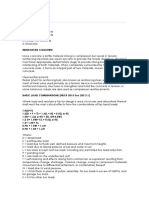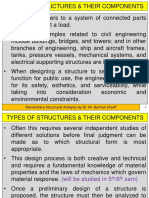Strema 101
Strema 101
Uploaded by
Hazel VidallonCopyright:
Available Formats
Strema 101
Strema 101
Uploaded by
Hazel VidallonOriginal Title
Copyright
Available Formats
Share this document
Did you find this document useful?
Is this content inappropriate?
Copyright:
Available Formats
Strema 101
Strema 101
Uploaded by
Hazel VidallonCopyright:
Available Formats
REVIEW – STRUCTURAL ENGINEERING AND CONSTRUCTION
`
SHEAR, BEARING AND TENSILE STRESS
MECHANICS OF DEFORMABLE BODIES
4. The lap joint is connected by three 20-mm-
Mechanics of materials – deals with the diameter rivets. Assuming that the axial load
internal effects and deformations that are P = 50 kN is distributed equally among the
caused by the applied loads. three rivets, find (a) the shear stress in a
rivet; (b) the bearing stress between a plate
AXIALLY LOADED BARS and a rivet; and (c) the maximum average
tensile stress in each plate.
1. The bar ABCD in consists of three
cylindrical steel segments with different
lengths and cross-sectional areas. Axial loads
are applied as shown. Calculate the normal
stress in each segment.
5. A key prevents relative rotation between
2. Figure shows a two-member truss supporting the shaft and the pulley. If the torque T =
a block of weight W. The cross-sectional areas 2200 N - m is applied to the shaft, determine
of the members are 800 mm2 for AB and 400 mm2 the smallest safe dimension b if the working
for AC. Determine the maximum safe value of W shear stress for the key is 60 MPa.
if the working stresses are 110 MPa for AB and
120 MPa for AC.
6. The bell crank, which is in equilibrium
under the forces shown in the figure, is
supported by a 20-mm-diameter pin at D that is
in double shear. Determine (a) the required
3. The rectangular diameter of the connecting rod AB, given that
wood panel is its tensile working stress is 100 MPa; and (b)
formed by gluing the shear stress in the pin.
together two boards
along the 30-degree
seam as shown in
the figure.
Determine the
largest axial force
P that can be
carried safely by
the panel if the
working stress for
the wood is 1120 psi, and the normal and shear
stresses in the glue are limited to 700 psi
and 450 psi, respectively.
INHINYERO REVIEW CENTER
REVIEW – STRUCTURAL ENGINEERING AND CONSTRUCTION
`
AXIAL DEFORMATION
7. The steel propeller shaft ABCD carries the
axial loads shown in the figure. Determine the
change in the length of the shaft caused by
these loads. Use E = 29 x 106 psi for steel.
8. The cross section of the 10-m-long flat
steel bar AB has a constant thickness of 20 11. The rigid bar AB is supported by two rods
mm, but its width varies as shown in the made of the same material. If the bar is
figure. Calculate the elongation of the bar due horizontal before the load P is applied, find
to the 100-kN axial load. Use E = 200 GPa for the distance x that locates the position where
steel. P must act if the bar is to remain horizontal.
Neglect the weight of bar AB.
9. The steel bars AC and BC, each of cross-
sectional area 120 mm2, are joined at C with a
pin. Determine the displacement of point C
caused by the 15-kN load. Use E = 200 GPa for
steel. GENERALIZED HOOKE‘S LAW
10. The rigid bars AB and CD are supported by
pins at A and D. The vertical rods are made of
aluminum and bronze. Determine the vertical
displacement of the point where the force P =
10 kips is applied. Neglect the weights of the
members.
INHINYERO REVIEW CENTER
REVIEW – STRUCTURAL ENGINEERING AND CONSTRUCTION
`
TRIAXIAL LOADING
STATICALLY INDETERMINATE PROBLEMS
13. The concrete post in figure is reinforced
axially with four symmetrically placed steel
bars, each of cross-sectional area 900 mm2.
Compute the stress in each material when the
1000kN axial load is applied. The moduli of
elasticity are 200 GPa for steel and 14 GPa
for concrete
SHEAR LOADING
14. The rigid block of mass M is supported by
the three symmetrically placed rods. The ends
of the rods were level before the block was
attached. Determine the largest allowable
value of M if the properties of the rods are
as listed (σ w is the working stress):
12. An initially rectangular element of
material is deformed as shown in the figure
(note that the deformation is greatly
exaggerated). Calculate the normal strains ε x
and ε y , and the shear strain γ for the
element.
INHINYERO REVIEW CENTER
REVIEW – STRUCTURAL ENGINEERING AND CONSTRUCTION
`
15. Before the 400-kN load is applied, the 18. The three steel rods, each of cross-
rigid platform rests on two steel bars, each sectional area 250 mm2, jointly support the
of cross-sectional area 1400 mm2, as shown in 7.5-kN load. Assuming that there was no slack
the figure. The cross-sectional area of the or stress in the rods before the load was
aluminum bar is 2800 mm2. Compute the stress applied, find the force in each rod. Use E =
in the aluminum bar after the 400-kN load is 200 GPa for steel.
applied. Use E = 200 GPa for steel and E = 70
GPa for aluminum. Neglect the weight of the
platform.
16. The rigid slab of weight W, with center of 19. The rigid bar ABC is supported by a pin at
gravity at G, is suspended from three B and two vertical steel rods. Initially the
identical steel wires. Determine the force in bar is horizontal and the rods are stress
each wire. free. Determine the stress in each rod if the
temperature of the rod at A is decreased by 40
°C. Neglect the weight of bar ABC. Use α =
11.7 x 106/°C and E = 200 GPa for steel.
17. The steel column of circular cross section
is attached to rigid supports at A and C. Find 20. The three steel wires, each of cross-
the maximum stress in the column caused by the sectional area 0.05 in2, support the weight W.
25-kN load. Their unstressed lengths are 74.98 ft, 74.99
ft, and 75.00 ft. (a) Find the stress in the
longest wire if W = 1500 lb. (b) Determine the
stress in the shortest wire if W = 500 lb. Use
E = 29 x 106 psi.
INHINYERO REVIEW CENTER
You might also like
- Inhinyero Review Center: Provided MaxDocument2 pagesInhinyero Review Center: Provided MaxVincent NavaNo ratings yet
- SCI P252 SecureDocument114 pagesSCI P252 SecureDan CiucuNo ratings yet
- Grade 9 Chemistry TextbookDocument2 pagesGrade 9 Chemistry TextbookTolentino60% (15)
- Strema 102Document4 pagesStrema 102Hazel VidallonNo ratings yet
- Review - Mathematics, Surveying and Transportation EngineeringDocument6 pagesReview - Mathematics, Surveying and Transportation EngineeringJustine Ejay MoscosaNo ratings yet
- σcosθ ρgd σ = surface tension in N/m θ = wetting angle, 0 for water d = diameter of tube in m ρ = density of fluidDocument1 pageσcosθ ρgd σ = surface tension in N/m θ = wetting angle, 0 for water d = diameter of tube in m ρ = density of fluidJustine Ejay MoscosaNo ratings yet
- Refresher 120Document2 pagesRefresher 120Jessie CaidoNo ratings yet
- Review - Structural Engineering and Construction: C 3 S 3 A C yDocument2 pagesReview - Structural Engineering and Construction: C 3 S 3 A C ymichael SonuganNo ratings yet
- Geotech 2: Gravel Original ModifiedDocument9 pagesGeotech 2: Gravel Original ModifiedJustine Ejay MoscosaNo ratings yet
- Statics 101Document4 pagesStatics 101Justine Ejay MoscosaNo ratings yet
- CE Board Nov 2020 - Hydraulics - Set 17Document2 pagesCE Board Nov 2020 - Hydraulics - Set 17Justine Ejay MoscosaNo ratings yet
- "Gtfiuctural Steel Dkign: Yletd Stress, Fy - Is That Unit Tensile Stress atDocument13 pages"Gtfiuctural Steel Dkign: Yletd Stress, Fy - Is That Unit Tensile Stress atMhiaBuenafeNo ratings yet
- Statics of Rigid Bodies 1Document3 pagesStatics of Rigid Bodies 1Rosette de AsisNo ratings yet
- Preliminary Sizing: Panel L, M L, M L /L Slab Design Min.h, M Min.h, MMDocument23 pagesPreliminary Sizing: Panel L, M L, M L /L Slab Design Min.h, M Min.h, MMTrol O'lolNo ratings yet
- FfghnvdzcklkuytfrdsxcvbnmDocument1 pageFfghnvdzcklkuytfrdsxcvbnmxxxxchrjycNo ratings yet
- Statics 2: Review - Structural Engineering and ConstructionDocument4 pagesStatics 2: Review - Structural Engineering and ConstructionJustine Ejay MoscosaNo ratings yet
- IM BSCE 3 - Hydraulics 1 Chapter 1 2021-2022Document36 pagesIM BSCE 3 - Hydraulics 1 Chapter 1 2021-2022acurvz2005No ratings yet
- Module 1 StaticsDocument2 pagesModule 1 StaticsAl Jay CruzadoNo ratings yet
- 2 MEC32-1 REVIEW OF MEC30 (Robles)Document16 pages2 MEC32-1 REVIEW OF MEC30 (Robles)John BurnsideNo ratings yet
- Tutorial 3Document2 pagesTutorial 3piyush kumarNo ratings yet
- MEGA Review Module - Strength of Materials 2 (Part 2)Document1 pageMEGA Review Module - Strength of Materials 2 (Part 2)Study BuddiesNo ratings yet
- Chapter 4 Flexural Design - (Part 5)Document35 pagesChapter 4 Flexural Design - (Part 5)Raja AliNo ratings yet
- Review - Mathematics, Surveying and Transportation EngineeringDocument11 pagesReview - Mathematics, Surveying and Transportation EngineeringPaulyne TuganoNo ratings yet
- Foundationxpart 1Document3 pagesFoundationxpart 1Haydeesheen SisonNo ratings yet
- Shear Strength-VI CorbelsDocument20 pagesShear Strength-VI CorbelsnaveenNo ratings yet
- Plate No. 2: Analysis and Design of Flexural MembersDocument12 pagesPlate No. 2: Analysis and Design of Flexural MembersIrene B. QuiñonesNo ratings yet
- Design of One Way Slab: Reference: NSCP 2001 Volume 1 Design of Reinforced Concrete by J.C. MccormacDocument25 pagesDesign of One Way Slab: Reference: NSCP 2001 Volume 1 Design of Reinforced Concrete by J.C. Mccormacamantz91No ratings yet
- Two Way Slab Direct Design Method (DDM) : Eng - Loai TarabulsiDocument45 pagesTwo Way Slab Direct Design Method (DDM) : Eng - Loai Tarabulsiمحمد الحمايدةNo ratings yet
- Assignments On Prestressed ConcreteDocument1 pageAssignments On Prestressed Concreteourebooks100% (1)
- MODULAR QUIZ - 56 - Steel DesignDocument9 pagesMODULAR QUIZ - 56 - Steel DesignCornelio J. FernandezNo ratings yet
- Week 3 - Analysis and Design of Short ColumnsDocument7 pagesWeek 3 - Analysis and Design of Short ColumnsMAYHAY ADRIAN PAULNo ratings yet
- Sec - PS2Document2 pagesSec - PS2Monica Amor AbengozaNo ratings yet
- RC 3Document4 pagesRC 3Jade David FranciscoNo ratings yet
- CE 470-Lect-3 (Analysis of Biaxially Loaded Columns) (Read-Only)Document22 pagesCE 470-Lect-3 (Analysis of Biaxially Loaded Columns) (Read-Only)Jamal RkhNo ratings yet
- EVALUATION EXAM RCD Steel Design 1 QuestionnaireDocument7 pagesEVALUATION EXAM RCD Steel Design 1 QuestionnaireGaming PalonNo ratings yet
- 1 CE132P - Introduction To Indeterminate Structures (Robles)Document7 pages1 CE132P - Introduction To Indeterminate Structures (Robles)Ramil T. Trinidad100% (1)
- Reinforce Concrete Design. Beam (Singly)Document4 pagesReinforce Concrete Design. Beam (Singly)Arj AsisNo ratings yet
- Arch 631Document17 pagesArch 631althea guanzonNo ratings yet
- Friction WedgesDocument7 pagesFriction Wedgespericharla ravivarmaNo ratings yet
- Design and Const2Document101 pagesDesign and Const2Sigue Ramel HinayasNo ratings yet
- Kippap-Handout-SEC (41 RCD - Footings W Moments)Document15 pagesKippap-Handout-SEC (41 RCD - Footings W Moments)top1echolocoNo ratings yet
- 04 ColumnDocument18 pages04 ColumnSamantha Isabel S AguimbagNo ratings yet
- Design of Beam-Aci-11-01-05Document23 pagesDesign of Beam-Aci-11-01-05aomareltayeb100% (1)
- 2 CE132P - Analysis of Indeterminate Structures - Method of Consistent DeformationDocument13 pages2 CE132P - Analysis of Indeterminate Structures - Method of Consistent DeformationEliminated Pro100% (1)
- Reinforced Concrete DesignDocument8 pagesReinforced Concrete DesignKriza-Ann BrionesNo ratings yet
- Republic of The Philippines: Battery - 1Document4 pagesRepublic of The Philippines: Battery - 1Michael James ll BanawisNo ratings yet
- RCD ExamDocument1 pageRCD ExamEmmanuel LazoNo ratings yet
- CE155P-2 Estimating, BOQ and BOMDocument26 pagesCE155P-2 Estimating, BOQ and BOMKelly Mae VirayNo ratings yet
- ACFrOgArCWH7TCgVohzg5jBTCo32F7RCwuz5sjVkSHaP7vyHCwOKHdBb0jHLeRHxxMlL1vhHUgtxE0Isl1uE nudE39BjtCwqrlt JsUT9SWOh5RYNPTflAw9gI3BjwDocument13 pagesACFrOgArCWH7TCgVohzg5jBTCo32F7RCwuz5sjVkSHaP7vyHCwOKHdBb0jHLeRHxxMlL1vhHUgtxE0Isl1uE nudE39BjtCwqrlt JsUT9SWOh5RYNPTflAw9gI3BjwJason RamosNo ratings yet
- Bolted and Riveted ConnectionsDocument1 pageBolted and Riveted ConnectionsJoshua TesoroNo ratings yet
- RCD Lecture 1Document26 pagesRCD Lecture 1Walter CatapangNo ratings yet
- CEMDEF40 Module 2 - Simple StressesDocument27 pagesCEMDEF40 Module 2 - Simple StressesengrrrrNo ratings yet
- Refresher Module-Structural Engineering (ACI-Moment Coefficient)Document1 pageRefresher Module-Structural Engineering (ACI-Moment Coefficient)Renz Ryan DolorNo ratings yet
- Quiz No 2 - Set DDocument2 pagesQuiz No 2 - Set DMayoune Nasinopa GalvezNo ratings yet
- Solved Problems Statically Indeterminate StructuresDocument5 pagesSolved Problems Statically Indeterminate StructuresChristopher Largado100% (2)
- 4 - Simple StrainDocument24 pages4 - Simple StrainLorene Ropeta.No ratings yet
- Tutorial No. 4-Axial Load & Temp StressesDocument4 pagesTutorial No. 4-Axial Load & Temp Stressesgodsake.mtengaNo ratings yet
- Assignment 2 On-Line Edition PDFDocument11 pagesAssignment 2 On-Line Edition PDFEm CervasNo ratings yet
- Mechanics of Deformable Bodies Review ProblemsDocument7 pagesMechanics of Deformable Bodies Review ProblemsadrianNo ratings yet
- PROBSET1 MergedDocument6 pagesPROBSET1 MergedAngelica Clave PascuaNo ratings yet
- Instructions on Modern American Bridge BuildingFrom EverandInstructions on Modern American Bridge BuildingNo ratings yet
- Instruction Manual: VideonicsDocument93 pagesInstruction Manual: VideonicsportalprofeticoNo ratings yet
- Cooper ElectronicDocument128 pagesCooper ElectronicRadio Parts100% (1)
- 02AeroModeller February 1962Document52 pages02AeroModeller February 1962drakhencNo ratings yet
- (GSM) Mobile To Mobile Call Flow, Within Same MSC/BSCDocument2 pages(GSM) Mobile To Mobile Call Flow, Within Same MSC/BSCluvdembadNo ratings yet
- Untitled PresentationDocument22 pagesUntitled PresentationDANi S SAMuelNo ratings yet
- Phetrattanarangsi 2017Document33 pagesPhetrattanarangsi 2017beki ayuuNo ratings yet
- COURSE SYLLABUS in (Code - Descriptive Title)Document7 pagesCOURSE SYLLABUS in (Code - Descriptive Title)Fernando BornasalNo ratings yet
- DOST RDI Laboratory ServicesDocument38 pagesDOST RDI Laboratory ServicesAtlas CerboNo ratings yet
- Final Project Itemize ChartsDocument11 pagesFinal Project Itemize ChartsVelvetNo ratings yet
- Photon Prog GuideDocument919 pagesPhoton Prog Guidesantosh_aditya2000100% (1)
- Ntps Fte CourseDocument20 pagesNtps Fte CourseShirat MohsinNo ratings yet
- Hyd Stru MastDocument193 pagesHyd Stru MastaajifNo ratings yet
- The Myth of Decentralized Execution in Air Operations 2Document8 pagesThe Myth of Decentralized Execution in Air Operations 2mniles1No ratings yet
- New Xiaomi Redmi Note 7-4-64 Tam Barusan Datang Murah Saja IDzHeajDocument1 pageNew Xiaomi Redmi Note 7-4-64 Tam Barusan Datang Murah Saja IDzHeajPaket NusveyNo ratings yet
- First 4 Weeks Planner PDFDocument5 pagesFirst 4 Weeks Planner PDFsampichardoNo ratings yet
- 3-Storeyed 31-3-2015-Schedule PDFDocument1 page3-Storeyed 31-3-2015-Schedule PDFSi Thu AungNo ratings yet
- Analysing-Pedagogic-Discourse David RoseDocument32 pagesAnalysing-Pedagogic-Discourse David RoseMarggie Laura Herrera BonillaNo ratings yet
- Important Factors Responsible For Making Event Effective and EfficientDocument11 pagesImportant Factors Responsible For Making Event Effective and EfficientJosephine ChirwaNo ratings yet
- Caleffi: Discal Magnetic Air and Dirt SeparatorDocument8 pagesCaleffi: Discal Magnetic Air and Dirt SeparatorSvetla NikolovaNo ratings yet
- Power Electronic Converter Design HandbookDocument232 pagesPower Electronic Converter Design Handbook2k18-EE-243 Vethushan VinnayagamoorththiNo ratings yet
- Lec-1b - Types of StructuresDocument23 pagesLec-1b - Types of StructuresNouman AhmadNo ratings yet
- Entrepreneurship Education in Zimbabwe: Research ArticleDocument27 pagesEntrepreneurship Education in Zimbabwe: Research Articlemunaxemimosa8No ratings yet
- Optimal Power Flow AnaDocument2 pagesOptimal Power Flow AnaAhmed Abd El WahabNo ratings yet
- MCQ On PCR (Polymerase Chain Reaction) - MCQ Biology - Learning Biology Through MCQsDocument6 pagesMCQ On PCR (Polymerase Chain Reaction) - MCQ Biology - Learning Biology Through MCQsPpa Gpat Amit100% (2)
- Research ApaDocument17 pagesResearch ApaJohn Lorenz InterinoNo ratings yet
- Review of Holy Greyhound by Jean Claude SchmittDocument2 pagesReview of Holy Greyhound by Jean Claude Schmittcolebtucker100% (1)
- Manual of Practical Medical Microbiology and ParasitologyDocument2 pagesManual of Practical Medical Microbiology and ParasitologyDjdjjd SiisusNo ratings yet
- MORPHOLOGY Bab ProductivityDocument29 pagesMORPHOLOGY Bab ProductivityAndaikutahu 45100% (1)
- Strategic Managing The Human Resources FunctionDocument3 pagesStrategic Managing The Human Resources FunctionPrincess Joy Morales100% (1)


























